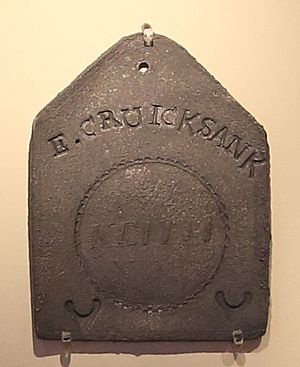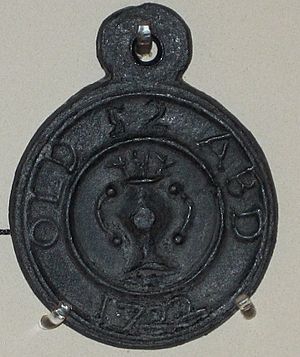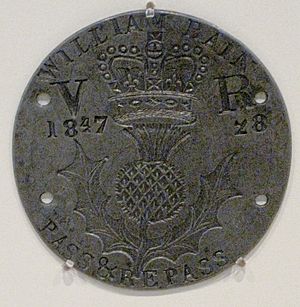Beggar's badge facts for kids
Beggars' badges were special badges or symbols worn by people who asked for money or food (called beggars) in Great Britain and Ireland. This started around the early 1400s. These badges had two main uses: they helped identify individual beggars, and they allowed beggars to travel freely from one place to another.
Why Were Badges Used?
For a long time, there was no clear system to help people who were very poor. In England and Scotland, laws called "poor laws" were created to try and help. These laws set up ways to support people who had no money or home.
Some older people, called bedesmen, were cared for by the Church or local towns. They often lived in special homes called hospitals, which were more like places of care than modern hospitals.
However, many poor people still had to look after themselves. This caused problems in towns and villages. So, people started using beggars' badges. One of the earliest mentions of such badges is from Valencia, Spain, where poor men had to wear a lead badge with the city's symbol.
In Britain, badges were introduced from the 1400s. They helped local leaders and churches control who was allowed to ask for alms (charity). This meant that only people with a badge could legally beg.
The badges also helped beggars move around. For example, some special beggars in Scotland, called "royal bedesmen," wore a badge that said "Pass and Re-Pass." This showed they had the right to travel from town to town to ask for help without being stopped. While some bedesmen had badges, it wasn't common for all of them. Some bedesmen in Scotland wore blue gowns instead of badges.

Where Can We See Examples?
Today, you can find many examples of beggars' badges in museums and private collections across the UK. Scotland seems to have a lot of them.
Sometimes, churches gave out special "communion tokens" instead of beggars' badges. Other groups also gave badges to people like street porters. There are also "pilgrims' badges," which were worn by people traveling to holy places, like the famous Santiago de Compostela. The scallop shell badge is still used by walkers on the Camino de Santiago (Way of St. James) today.
The National Museum of Scotland has a collection of 110 badges, with 20 of them on display. Glasgow Museums have four badges. The University of Aberdeen has seven badges, including some from Old Aberdeen and other parts of northeast Scotland.
One of the most famous beggars' badges is at the National Museum in Edinburgh. It's a royal bedesmen badge that says "Pass and Re-Pass." This badge clearly shows the connection between bedesmen and beggars.
See also
- Bede House, Old Aberdeen
- Hospitals in medieval Scotland
- Aberdeen trades hospitals
- Kincardine O'Neil Hospital, Aberdeenshire
- Scottish Bedesmen
- Soutra Aisle
- Provand's Lordship
- David Allan
- Bishop Dunbar's Hospital
- Aberdeen poorhouses



